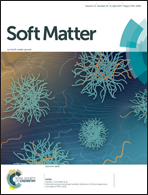Self-assembly of gradient copolymers synthesized in semi-batch mode by nitroxide mediated polymerization†
Abstract
The effect of diffuse compositional interfaces on copolymer self-assembly was studied via gradient copolymers (GCP). Poly(methyl methacrylate)-grad-(styrene) (PMMA-grad-PSt) copolymers were synthesized in semi-batch mode using nitroxide-mediated polymerization (NMP) with varied monomer injection protocols to produce varied diffuse interfaces (number average molecular weights (Mn) ranged from 62 000 g mol−1 to 94 000 g mol−1 with dispersities (Đ) between 1.35 and 1.59). The GCPs were spun into thin films on substrates made neutral by (St-ran-MMA-ran-hydroxyethyl methacrylate) terpolymers and annealed at elevated temperature to produce vertically oriented microphase-separated domains. The GCPs were found to have domain spacing larger than equivalent monodisperse BCPs, due to their polydisperse nature. This effect was partially offset by the decrease in χ due to the gradient. GCPs synthesized with a single-injection protocol (i.e. less diffuse interfaces) were found to self-assemble into ordered domains. However, GCPs synthesized with long injection times (i.e. more diffuse interfaces) exhibited poor self-assembly attributed to their predicted statistical-copolymer-like middle sequence, which caused a reduction of the effective enthalpic interaction parameter.



 Please wait while we load your content...
Please wait while we load your content...